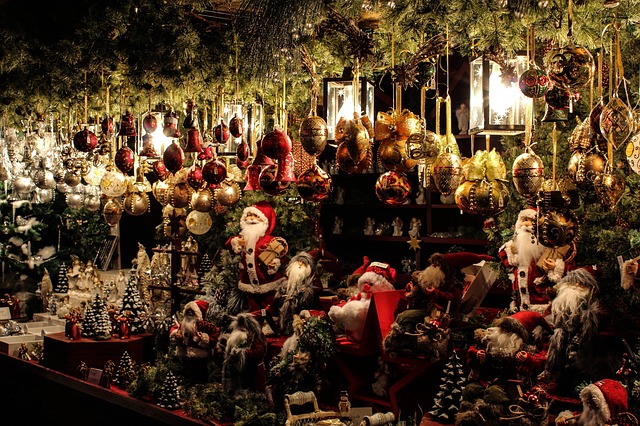Americans People’s Celebrate Christmas with Many Traditions

Christmas 2023
The birth of Jesus of Nazareth is remembered during Christmas, which is observed by the majority of Christians on December 25. Like many other nations, Americans have established their own Christmas customs and observances, which have undergone significant change over time.
Also Read:- Christmas Markets in the USA: Opening Dates for 2022
Most Americans today combine their family traditions with religious and secular traditions, frequently including foods, decorations, and rituals from locations they or their ancestors previously called home. Christmas dinner favourites include roast turkey and ham across the nation, but regional preferences may also include tamales, roast goose with red cabbage, crawfish jambalaya, roast pork, or a seafood feast called “seven fishes.”
On Christmas Eve, luminarias—lanterns created from brown paper bags illuminated by lit candles and weighed down with sand—are shown in the Southwest. The procession known as Las Posadas, which depicts Mary and Joseph looking for a place to stay in Bethlehem, is a popular celebration among Mexican Americans. St. Lucia festivals are held by the Swedish Americans, and in Puerto Rico there are parrandas, where friends sing traditional melodies while going from house to house, “surprising” and awakening their friends.
Even though Christmas is a religious holiday for many Americans, its position as a legal holiday has been upheld by the federal courts. According to one court’s reasoning, “the government is doing little more than recognising the cultural significance of the holiday by providing federal employees with a paid vacation day on Christmas.”
Non-Christian holidays observed around the same time of year as Christmas, most notably the Jewish Hanukkah and the African-American Kwanzaa, are somewhat incorporated into a larger “holiday season.”
THE HISTORY OF AMERICAN CHRISTMAS
Loud Christmas celebrations were frowned upon by the early New England Puritans. Christmas continued to be a normal workday in parts of New England and Pennsylvania even after the Massachusetts colonists briefly made celebrating the day illegal in 1659. However, some regions of British North America celebrated enthusiastically, with costumed partygoers visiting homes and giving out little presents of food and drink.
With the growing tradition of buying gifts for young children, the contemporary, commercialised Christmas started to take shape in the 19th century. Seasonal “Christmas shopping” started to become more significant economically.
Similar to how other Christmas customs started in the 19th century. Through literary creations like the 1823 poem “A Visit from Saint Nicholas,” Santa Claus—whose names are a combination of the German Saint Nicholas and the Dutch Sinter Klaas—took on the image of a cheery gift-giver and reindeer-drawn sleigh driver.
Christmas trees are credited with being a 16th-century invention in Germany. Legend has it that Martin Luther, a Protestant reformer, was the first to decorate a tree with lit lights in order to teach his children about the wonders of God’s creation. In the nineteenth century, Christmas trees gained popularity in both Britain and the United States. Nowadays, lots of people in the United States buy a live evergreen tree or a reusable aluminium and plastic model and deck it up with lights and decorations. Christmas gifts may be placed under the tree by family members on the morning of December 25 or, as some children think, by Santa Claus himself after he lands his sleigh and reindeer on the roof and descends the chimney.
In the latter quarter of the 19th century, mass-produced Christmas cards first appeared. Currently, these could show religious settings or communicate secular, frequently comedic, ideas. Although sending “e-cards” electronically via the Internet is becoming more and more common, throughout the holiday season, Americans will ship almost 16.6 billion Christmas cards, letters, and packages.
CURRENT OBSERVATIONS
Christmas has turned into its own “season” because Christmas shopping is so crucial to some merchants. Today “Black Friday” refers to the day after Thanksgiving, which falls on the fourth Thursday in November. It is a significant shopping day that can contribute significantly to annual profits and propel certain enterprises into profitability, or “in the black.”
However, there is much more to this lengthy holiday season than just shopping. It serves as a time of year for philanthropic giving and volunteer activity for many Americans.
Regarding holiday entertainment, you can find carolers everywhere, endless renditions of Tchaikovsky’s Nutcracker ballet, and school holiday pageants. Adults watch classic films like It’s a Wonderful Life (1946) and Miracle on 34th Street (1945) while kids (and sentimental parents) watch animated classics like A Charlie Brown Christmas (1965). Many radio stations change their programming to include holiday music. Because so many eagerly anticipated contenders for the Academy Awards (or “Oscars”) are released in December, the Christmas movie season is frequently referred to as the “Oscar season.”
However, many people still view the holiday’s original religious significance as being its most crucial component. Some churches make manger scenes, which are dioramas of the stable where Jesus is said to have been born, complete with figurines of the baby Jesus and those who were there when he was born. Numerous churches offer midnight or candlelight services on Christmas Eve. Some events feature a Nativity Mass or a portrayal of Jesus’ birth on stage.
Christmas in the United States represents the principles of a free and diverse people, as with so many other facets of American cultural life.








